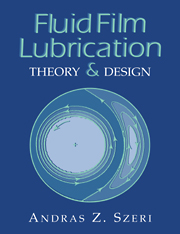Book contents
- Frontmatter
- Contents
- Preface
- 1 Introduction
- 2 Basic Equations
- 3 Thick-Film Lubrication
- 4 Dynamic Properties of Lubricant Films
- 5 Effects of Fluid Inertia
- 6 Flow Stability and Transition
- 7 Turbulence
- 8 Elastohydrodynamic Lubrication
- 9 Thermal Effects
- 10 Lubrication with Non-Newtonian Fluids
- 11 Gas Lubrication
- Index
11 - Gas Lubrication
Published online by Cambridge University Press: 12 January 2010
- Frontmatter
- Contents
- Preface
- 1 Introduction
- 2 Basic Equations
- 3 Thick-Film Lubrication
- 4 Dynamic Properties of Lubricant Films
- 5 Effects of Fluid Inertia
- 6 Flow Stability and Transition
- 7 Turbulence
- 8 Elastohydrodynamic Lubrication
- 9 Thermal Effects
- 10 Lubrication with Non-Newtonian Fluids
- 11 Gas Lubrication
- Index
Summary
The qualitative difference in performance between liquids and gases, in general, vanishes as M → 0, where the Mach number, M, is the ratio of the fluid velocity to the local velocity of sound. This general conclusion also holds for bearings, and at low speeds the behavior of gas film lubricated bearings is similar to liquid-lubricated bearings – in fact, many of the liquid film bearings could also be operated with a gas lubricant. This similarity between liquid and gas films no longer holds at high speeds, however, the main additional phenomenon for gas bearings being the compressibility of the lubricant.
Perhaps the earliest mention of air as a lubricant was made by Him in 1854. Kingsbury (1897) was the first to construct an air-lubricated journal bearing. But the scientific theory of gas lubrication can be considered as an extension of the Reynolds lubrication theory. This extension was made soon after Reynolds' pioneering work: Harrison in 1913 published solutions for “long” slider and journal bearings lubricated with a gas. Nevertheless, the study of gas lubrication remained dormant until the late 1950s, when impetus for the development of gas bearings came mainly from the precision instruments and the aerospace industries.
In self-acting bearings, whether lubricated by liquid or gas, lubrication action is produced in a converging narrow clearance space by virtue of the viscosity of the lubricant. As the viscosity of gases is orders of magnitude smaller than that of commonly used liquid lubricants, gas bearings generally must have smaller clearances and will produce smaller load capacities than their liquid-lubricated counterparts.
- Type
- Chapter
- Information
- Fluid Film LubricationTheory and Design, pp. 392 - 408Publisher: Cambridge University PressPrint publication year: 1998



